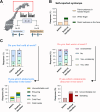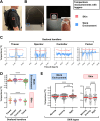Impact of cold exposure on shift working seafood handlers in Northern Norway: a comparative analysis across work shifts
- PMID: 40551215
- PMCID: PMC12183870
- DOI: 10.1186/s12995-025-00469-2
Impact of cold exposure on shift working seafood handlers in Northern Norway: a comparative analysis across work shifts
Abstract
Objective: This study aimed to investigate the impact of occupational thermal exposure on shift workers, specifically whether cold exposure elicits distinct physiological responses and thermoregulatory recovery across different tasks and shift types.
Methods: Observational study at two factories processing prawns in Northern Norway in which 32 shift-working seafood handlers with different task responsibilities were followed for a single shift (morning, evening, night). The participants answered questionnaires regarding thermal exposures at work and related symptoms; these were compared to answers from 12 administration workers. Personal thermal loggers measured the range of temperature exposures associated with four different seafood handler work tasks. Pre- and post-shift plasma levels of FGF21, GDF15 and cytokines were analysed using immunoassays. As a proxy for thermoregulatory response across different shift types, hand temperature was measured repeatedly before and after breaks using a thermal imaging camera.
Results: Most seafood handlers reported subjective impact from cold exposure. Cold working conditions of ≤ 10 ℃ were measured across all shifts and three different seafood handling tasks. The morning shift-seafood handlers displayed lower plasma FGF21 post-shift vs. pre-shift; the evening and night shifts showed no difference. GDF15 levels remained unchanged regardless of shift types but were positively correlated with age. Night shift was associated with increased plasma IL6 post-shift vs. pre-shift. Thermoregulatory responses showed a positive linear relationship with break duration but did not differ between shifts.
Conclusions: The findings suggest that exposure levels are closely linked to specific tasks and shifts, with thermoregulatory responses varying by task type and time of day.
Keywords: Breaks; Cold exposure; Occupational health; Shift work; Thermoregulation.
© 2025. The Author(s).
Conflict of interest statement
Declarations. Ethics approval and consent to participate: The research has been performed in accordance with the Declaration of Helsinki and approved by the Norwegian Regional Committee for Medical and Healthcare Research Ethics (REK); reference number 384542. All participants provided written informed consent prior to participating in the study. Consent for publication: Not applicable. Competing interests: The authors declare no competing interests.
Figures






References
-
- (FAO), F.a.A.O.o.t.U.N. The State of World Fisheries and Aquaculture. 2020; Available from: https://openknowledge.fao.org/server/api/core/bitstreams/170b89c1-7946-4....
-
- Thomas Nyrud, A.I., Bjørn Inge Bendiksen, Roy Robertsen, Silje Steinsbø. Sjømatnæringens ringvirkninger - Verdiskaping og ringvirkninger fra norsk sjømatnæring for 2022. 2023; Available from: https://nofima.no/publikasjon/2198370/.
-
- Mäkinen TM, Hassi J. Health problems in cold work. Ind Health. 2009;47(3):207–20. - PubMed
-
- Rintamaki H. Performance and energy expenditure in cold environments. Alaska Med. 2007;49(2 Suppl):245–6. - PubMed
LinkOut - more resources
Full Text Sources
Research Materials

